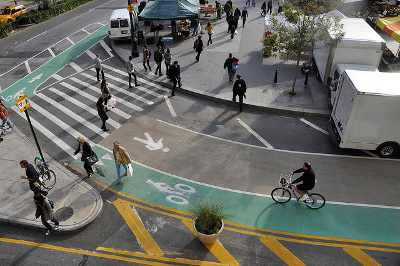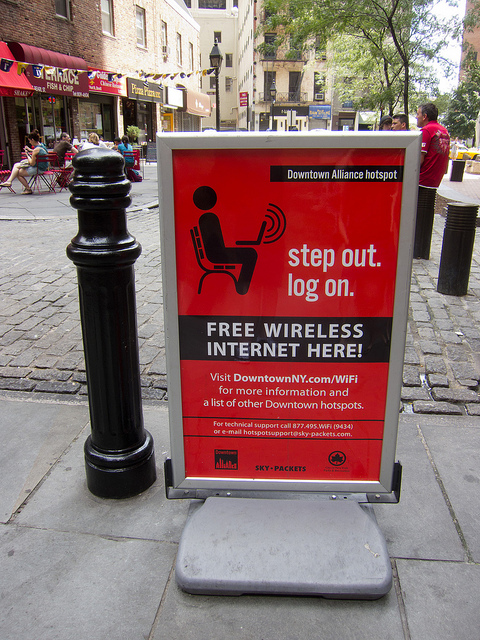
Smart projects are developing around the world and all eyes are on cities like Copenhagen and Barcelona where smart projects are becoming commonplace in daily life. But what is being done in NYC to become a smarter city? New York International takes a look into the four components that create a smart city and explores what projects NYC is up to.
Energy and Water
White Roofs – New York’s temperature is continuing to rise which pushes up energy use and energy prices. Since the sun is attracted to anything black, the folks at NYC °Cool Roofs had a great idea: let’s paint the roofs white. Painting the roofs with their special reflective white coating helps lower air pollution (by reducing power demand), extends the life of roof surfaces (by reducing wear and tear from heating and cooling), and reduces the internal building temperatures by up to 30%. Pretty “cool” idea if you ask us. The team has already covered over 5 million square feet of roof and has no plans of slowing down.Vision 2020: Comprehensive Waterfront Plan – Hurricane Sandy was a major disruptor, but called attention to the need to improve NYC shorelines. The plan possesses eight main goals, which include expanding public access to the waterfront, supporting economic development along the waterfront, improving water quality, and increasing the city’s resilience to climate change.
Mobility and Transportation
 Citi Bike Share Program – NYC has joined some of the world leaders in providing an effective bike share program. Officially launching the program in 2013, the City worked to establish bike lanes throughout NYC and placed thousands of bikes and hundreds of stations across Manhattan and Brooklyn. Citi even created an app that helps you locate available bikes. We love it, celebrities love it, New Yorkers love it, you’ll love it. Need help navigating the system? We’ve laid out the ins and outs of biking in the city.Midtown in Motion (MIM Project) – Space is something New York City does not have an abundance of, so smart solutions to better utilize what is available are certainly needed. In 2012, NYC was awarded the ITS America Smart Solution Spotlight Award for the Midtown in Motion Project. MIM was a re-design of Times Square to better utilize space. The City began by closing part of Broadway to traffic and added public seating. The project continued by creating a sophisticated traffic management system to ease congestion, improve traffic flow, and reduce air pollution on one of the city’s most congested streets. In addition, the City committed to integrating “smart technologies” that transmit traffic information wirelessly to help engineers respond to traffic conditions in real time.
Citi Bike Share Program – NYC has joined some of the world leaders in providing an effective bike share program. Officially launching the program in 2013, the City worked to establish bike lanes throughout NYC and placed thousands of bikes and hundreds of stations across Manhattan and Brooklyn. Citi even created an app that helps you locate available bikes. We love it, celebrities love it, New Yorkers love it, you’ll love it. Need help navigating the system? We’ve laid out the ins and outs of biking in the city.Midtown in Motion (MIM Project) – Space is something New York City does not have an abundance of, so smart solutions to better utilize what is available are certainly needed. In 2012, NYC was awarded the ITS America Smart Solution Spotlight Award for the Midtown in Motion Project. MIM was a re-design of Times Square to better utilize space. The City began by closing part of Broadway to traffic and added public seating. The project continued by creating a sophisticated traffic management system to ease congestion, improve traffic flow, and reduce air pollution on one of the city’s most congested streets. In addition, the City committed to integrating “smart technologies” that transmit traffic information wirelessly to help engineers respond to traffic conditions in real time.
Health and Wellness
Pilot Health Tech NYC – An initiative of NYCEDC, Pilot Health Tech NYC is a program that provides $1 million in funding to innovative projects in smart health technologies, pushing NYC to the forefront of emerging technologies. The winners for 2014 run the gamut in smart technologies; one of the favorites was Smart Vision Labs, which hopes to revolutionize having your vision checked by simply taking a picture of your eye with your smartphone.
Pocket Parks and the High Line – Green space is a rare commodity in a dense city, and pocket parks were a spirited idea to make the even the littlest spaces count. Pocket parks – privately owned public spaces – improve air quality and public life. This way in which New Yorkers utilize small spaces has been praised by Frank Jensen, Mayor of Copenhagen, for its success. Another example of creating new green spaces is the High Line. After the High Line, a historic railway line, fell into disrepair, the High Line, an innovative community park, was born. Keeping the name, the city of New York reused wasted space and created a community park that also serves as human-centered mobility. The success will hopefully inspire more projects merging urban space and transport in city planning.
Urban Data and Information
 Phone Booths into WiFi Booths – Out with the old and in with the new! NYC’s plan is to build the largest city-wide WiFi network in the nation, and they’ve starting the process by replacing 7,300 old phone booths with free WiFi hot spot stations (because who really uses pay phones anymore?) The city began with 10 hotspots, providing internet access for up to 200 feet and the number is expected to grow every year. The hotspots will also offer 911 and 311 calling ability and include tablets that give you information on transit, parks, public safety, and will even allow users to connect with local government.Smart Roofs to Cut Crime – New York is proud of the decrease in gun violence, yet even one incident is still too many. Can urban infrastructure be used as a form of surveillance? As part of a 2-year pilot program, microphone-based rooftop sensors by ShotSpotter are being installed in select areas across the city. The sensors help police by pinpointing the location of a gun shot in real time.Smart Grid – As part of the US Department of Energy’s smart grid stimulus, Con Edison is developing a smart grid for NYC and the surrounding areas. A smart grid integrates information and communication technology into electricity generation helping consumers use energy more efficiently.NYU CUSP – Located in Brooklyn, CUSP is a technology and research institute which has a variety of projects focusing on the area of smart cities. Most recently they have partnered with the Hudson Yards project to use data sharing across many platforms so that the development can become the first “quantified community.” They will collect and analyze information on the activity levels of residents, pedestrian traffic patterns, air quality, energy consumption and more to be used to make smarter decisions in all areas of the built environment.
Phone Booths into WiFi Booths – Out with the old and in with the new! NYC’s plan is to build the largest city-wide WiFi network in the nation, and they’ve starting the process by replacing 7,300 old phone booths with free WiFi hot spot stations (because who really uses pay phones anymore?) The city began with 10 hotspots, providing internet access for up to 200 feet and the number is expected to grow every year. The hotspots will also offer 911 and 311 calling ability and include tablets that give you information on transit, parks, public safety, and will even allow users to connect with local government.Smart Roofs to Cut Crime – New York is proud of the decrease in gun violence, yet even one incident is still too many. Can urban infrastructure be used as a form of surveillance? As part of a 2-year pilot program, microphone-based rooftop sensors by ShotSpotter are being installed in select areas across the city. The sensors help police by pinpointing the location of a gun shot in real time.Smart Grid – As part of the US Department of Energy’s smart grid stimulus, Con Edison is developing a smart grid for NYC and the surrounding areas. A smart grid integrates information and communication technology into electricity generation helping consumers use energy more efficiently.NYU CUSP – Located in Brooklyn, CUSP is a technology and research institute which has a variety of projects focusing on the area of smart cities. Most recently they have partnered with the Hudson Yards project to use data sharing across many platforms so that the development can become the first “quantified community.” They will collect and analyze information on the activity levels of residents, pedestrian traffic patterns, air quality, energy consumption and more to be used to make smarter decisions in all areas of the built environment.

